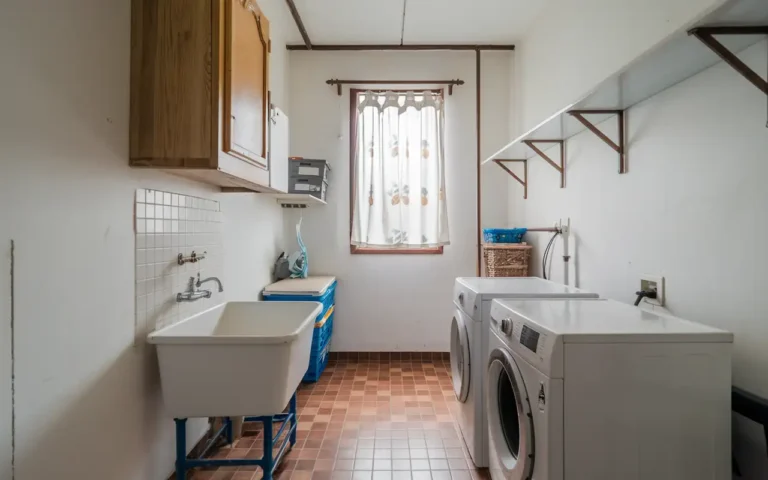27 Stunning Sage Green Kitchen Ideas That Transform Your Space
Sage green has emerged as the perfect kitchen color, balancing trendy appeal with timeless sophistication.
This versatile hue brings nature’s calming influence indoors while creating a backdrop that complements multiple design styles.
Kitchen designers consistently rank sage among their favorite colors because it works beautifully with wood tones, metals, and natural stones.
The subtle green undertones create a sense of freshness without overwhelming your space.
Ready to incorporate this designer-approved color into your kitchen? These ideas will help you transform your cooking space with sage green’s soothing yet sophisticated presence.
1: Sage Green Cabinetry
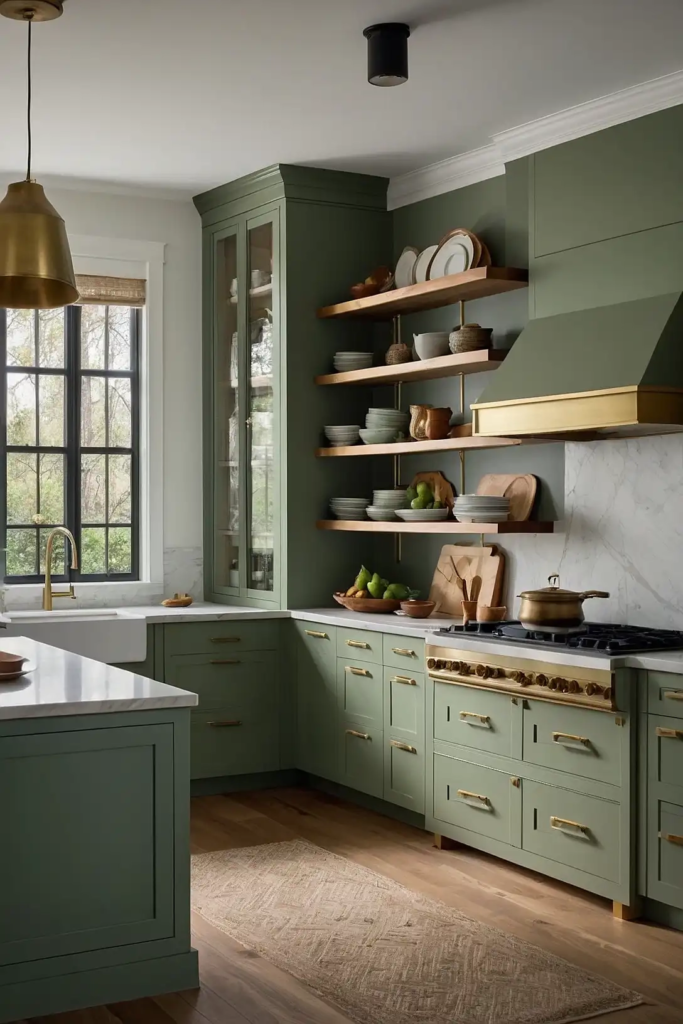
Transform your kitchen with full sage green cabinetry that creates a cohesive, enveloping color experience.
This commitment to color establishes a distinctive character throughout your space. The soft hue makes even large expanses of cabinetry feel less imposing than darker colors.
Choose matte or satin finishes that highlight the subtle undertones in different lighting conditions.
Pair with simple hardware in brass or matte black for a contemporary yet timeless combination.
2: Sage and White Two-Tone Cabinets
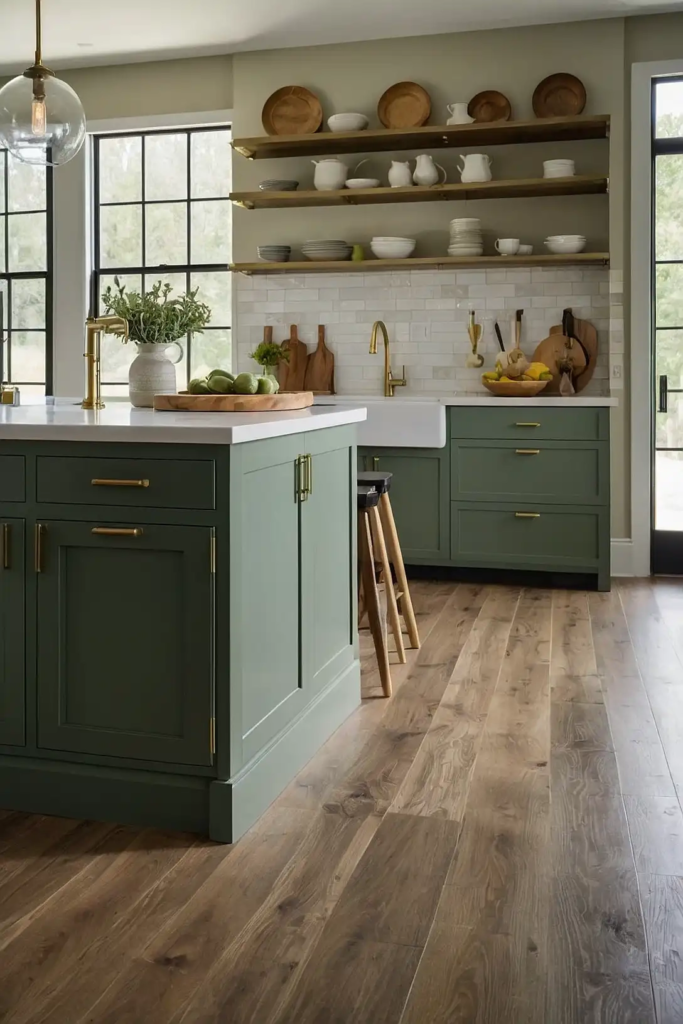
Create visual interest with sage green lower cabinets paired with white uppers. This two-tone approach maintains brightness at eye level while grounding the space with color below.
The split color treatment prevents sage from overwhelming smaller kitchens. White upper cabinets reflect light, making your space feel larger and airier.
This combination works particularly well with open shelving interspersed among upper cabinets.
3: Sage Green Kitchen Island
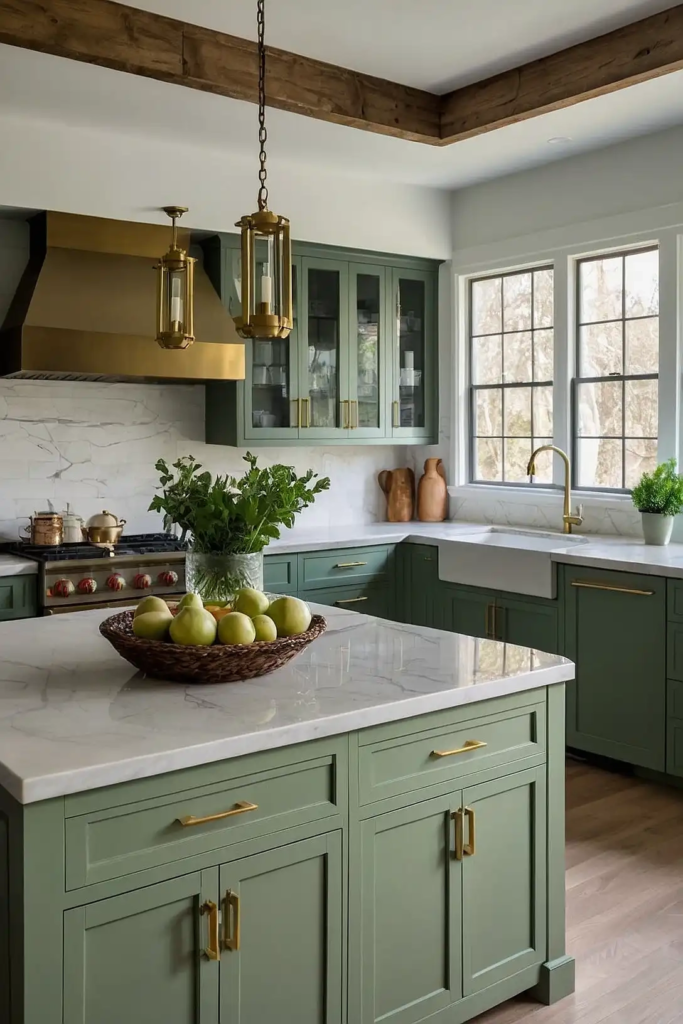
Make your island a focal point with sage green cabinetry that contrasts with perimeter cabinets. This targeted color application creates a furniture-like centerpiece.
Choose a slightly darker sage for your island than your wall color for subtle definition.
The island’s vertical surfaces provide significant color impact without requiring a full kitchen commitment.
This approach works beautifully in both open-concept spaces and traditional enclosed kitchens.
4: Sage Green Subway Tile Backsplash
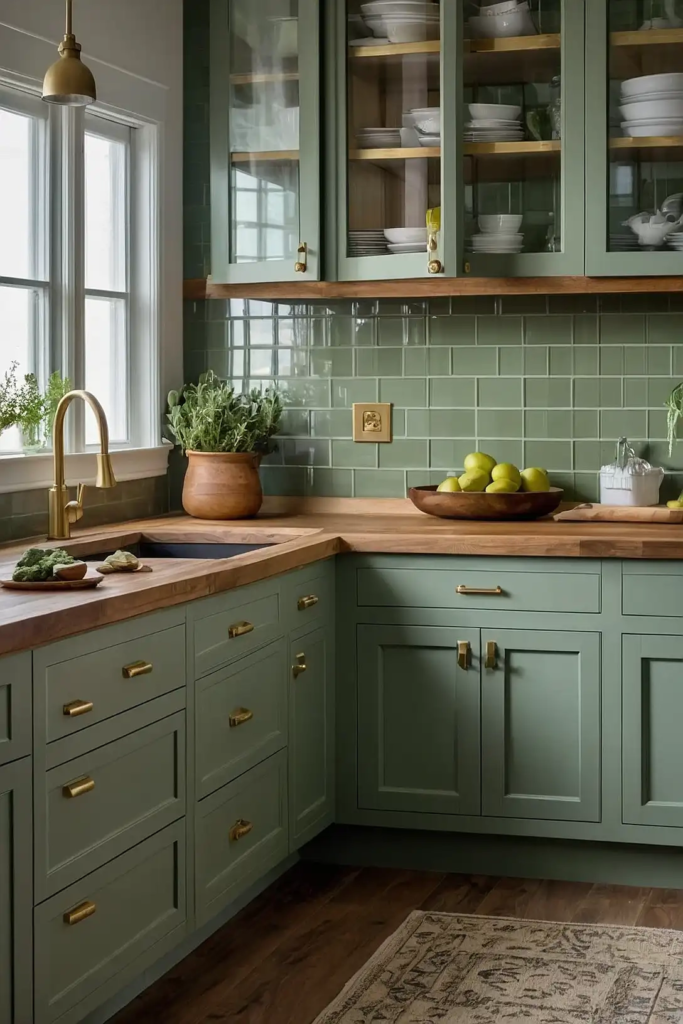
Install sage green subway tiles for a backsplash that adds color while maintaining classic appeal. The traditional shape keeps the look timeless while the color adds personality.
Choose handmade or zeolite-style tiles with slight variations for added depth and character.
The slight dimensional differences catch light beautifully, creating subtle movement. Extend the tile from countertops to upper cabinets or ceiling for maximum impact.
5: Sage Green Accent Wall
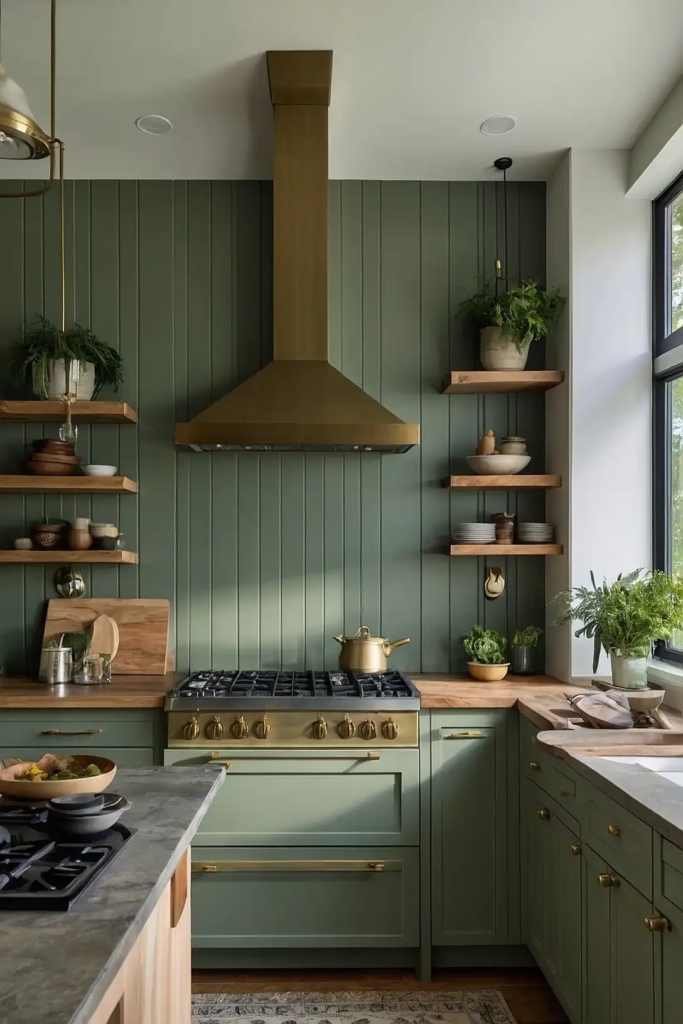
Paint a single kitchen wall in sage green to add color without commitment. This approach works particularly well in rental properties or for color-shy homeowners.
Select a wall without cabinets or major appliances for uninterrupted color impact. The accent wall creates a perfect backdrop for open shelving or artwork.
This budget-friendly option instantly transforms your kitchen with minimal effort and expense.
6: Soft Sage Countertops
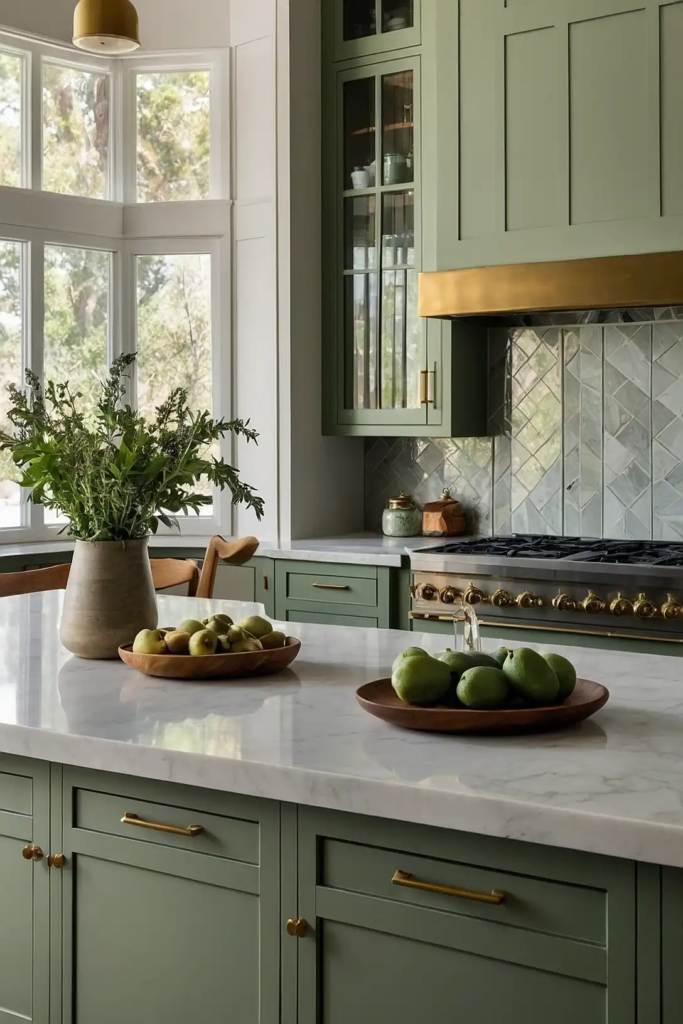
Install sage-tinted concrete, quartz, or composite countertops for unexpected color in a typically neutral element.
This surface-level application adds subtle character throughout your workspace.
Choose materials with subtle variation rather than solid color for natural authenticity. The horizontal planes catch light differently throughout the day, creating visual interest.
This unconventional choice pairs beautifully with white or wood cabinetry for balanced contrast.
7: Sage Green Range Hood
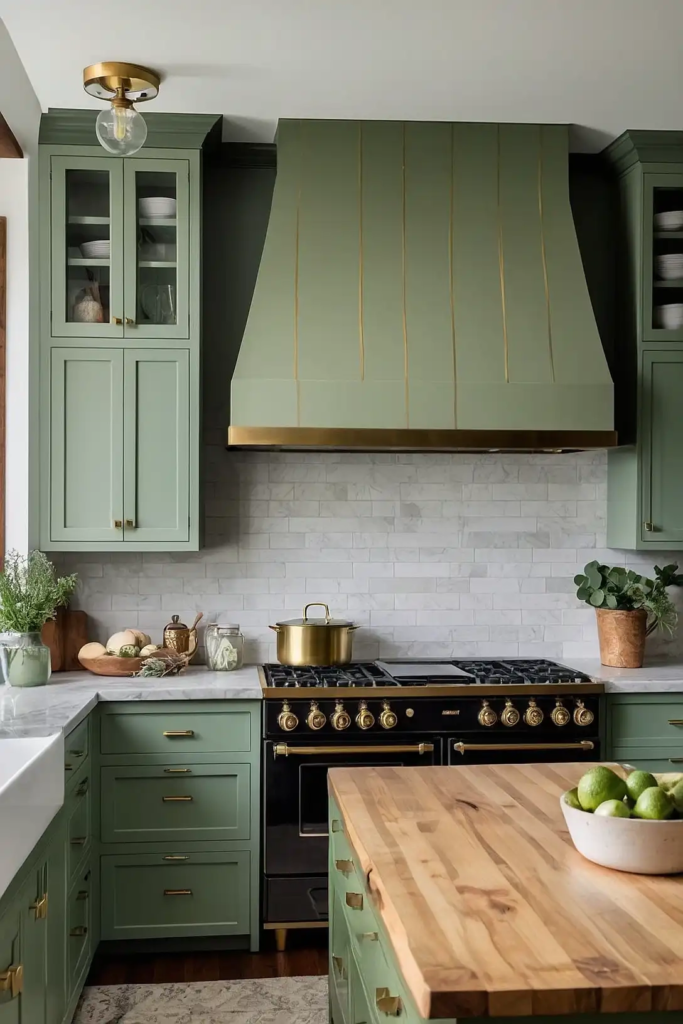
Make your ventilation hood a statement piece by wrapping it in sage green metal or painting a custom cover. This unexpected focal point draws the eye upward.
Choose a slightly darker sage than your cabinetry for subtle distinction. The vertical element creates architectural interest while maintaining your color story.
This application works especially well in kitchens with high ceilings or open concepts.
8: Sage Green Kitchen Appliances

Incorporate sage green appliances for vintage charm with contemporary function. Major manufacturers now offer subdued green finishes in professional-grade equipment.
Focus this color application on statement pieces like ranges or refrigerators. The colored appliances become functional art pieces within your kitchen design.
Balance with neutral cabinetry or complement with matching sage cabinets for a monochromatic statement.
9: Sage Green Window Treatments

Frame kitchen windows with sage green roman shades, curtains, or shutters that filter light while adding color. This textile application softens hard kitchen surfaces.
Choose washable fabrics designed specifically for kitchen environments. The color applied at windows catches natural light beautifully, highlighting sage’s complex undertones.
This easily changeable element allows seasonal color adjustments without permanent commitment.
10: Sage Green Ceiling
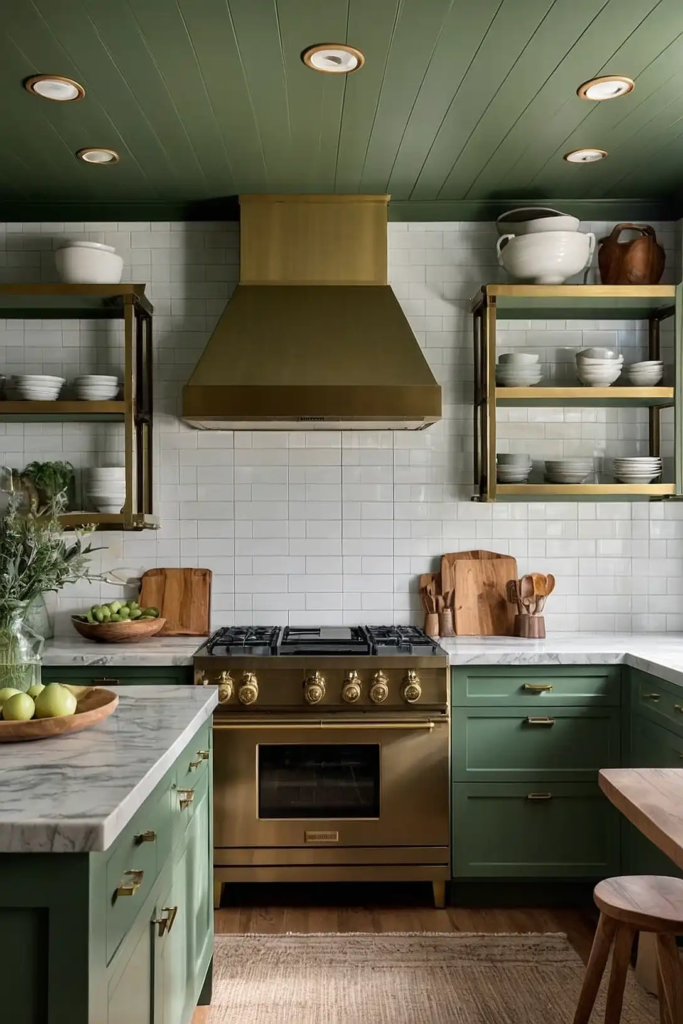
Paint your kitchen ceiling sage green for an unexpected color application that creates architectural interest. This often-overlooked surface becomes a distinctive design element.
Choose a shade slightly lighter than your wall color for a natural color progression. The overhead color creates a cocooning effect that makes larger kitchens feel more intimate.
This approach works particularly well with white cabinets and walls for dramatic contrast.
11: Sage Green Floor Tiles
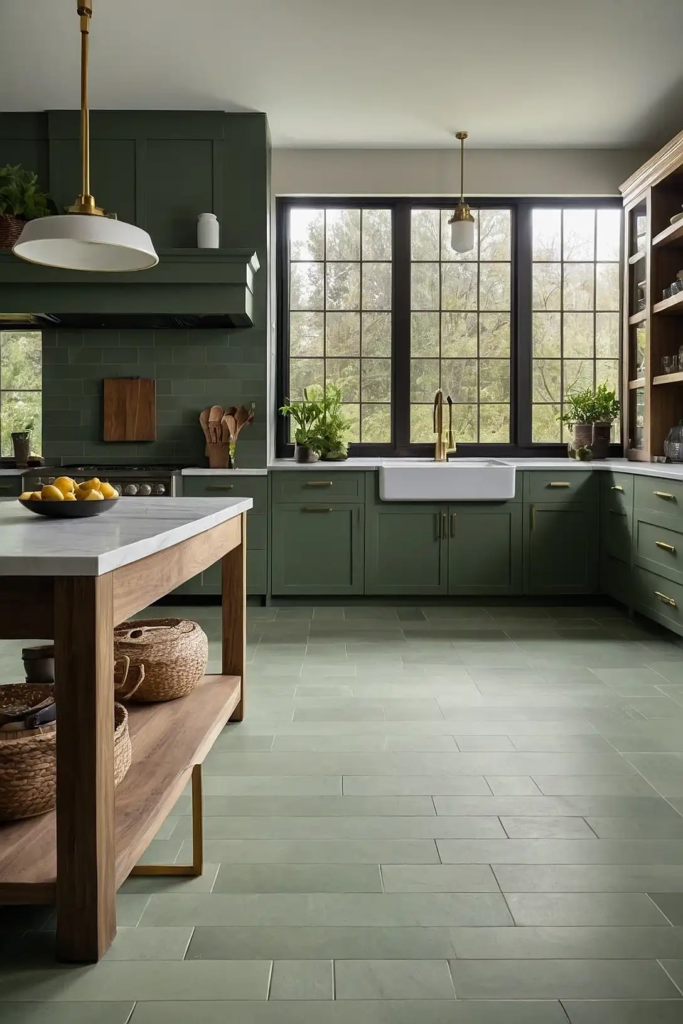
Install sage green ceramic, porcelain, or cement tiles for a foundation of color that grounds your entire kitchen. This application creates impact while remaining practical.
Select matte finishes that provide slip resistance and hide footprints effectively. The expansive horizontal color plane establishes your palette throughout the space.
Consider geometric patterns that incorporate sage with complementary neutrals for added dimension.
12: Sage Green Pendant Lights

Hang sage green pendant lights above islands or sinks to bring color to eye level. These functional fixtures double as decorative elements within your color scheme.
Choose ceramic, metal, or glass pendants in various sage tones. The lighting elements create color consistency between upper and lower kitchen zones.
Position at different heights for visual interest while maintaining practical task lighting.
13: Sage Open Shelving
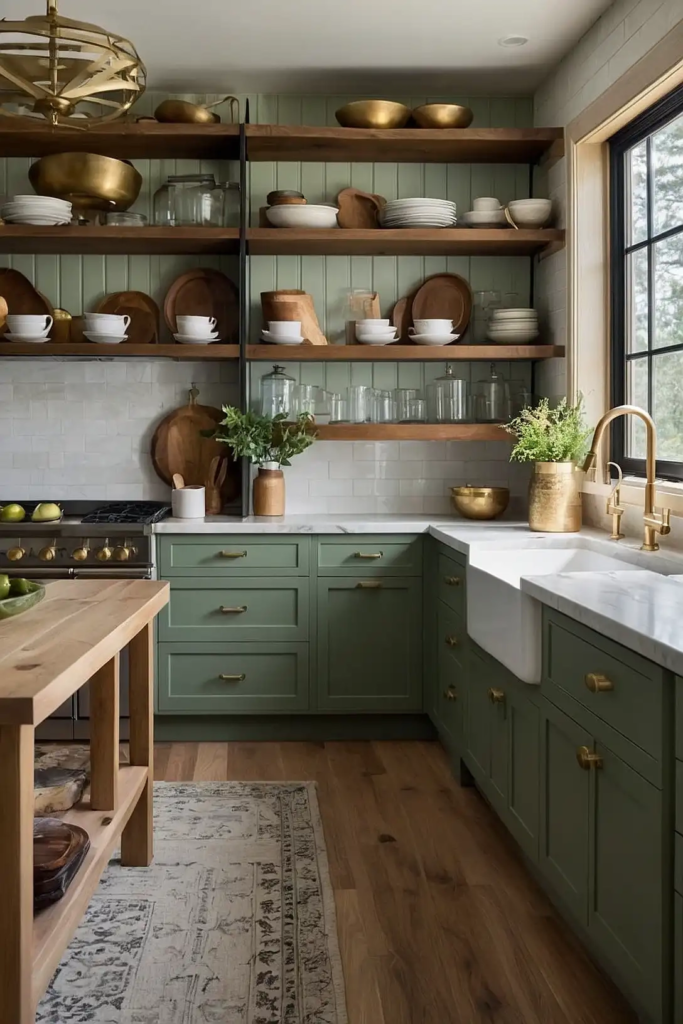
Replace upper cabinets with sage green floating shelves that display dishware while adding color. This open storage solution creates breathing room in smaller kitchens.
Install substantial brackets that support both visual weight and practical function. The horizontal color elements break up wall expanses while providing accessible storage.
Style with contrasting white dishes or complementary natural wood tones for balanced display.
14: Sage Green Kitchen Furniture

Incorporate a sage green kitchen table, chairs, or stools that continue your color story through furniture elements. These movable pieces add color without permanent commitment.
Choose wooden pieces painted sage or upholstered items in sage fabrics. The furniture elements soften the harder surfaces typical in kitchens.
This approach allows you to introduce sage without changing fixed elements like cabinetry or tile.
15: Sage and Wood Combination
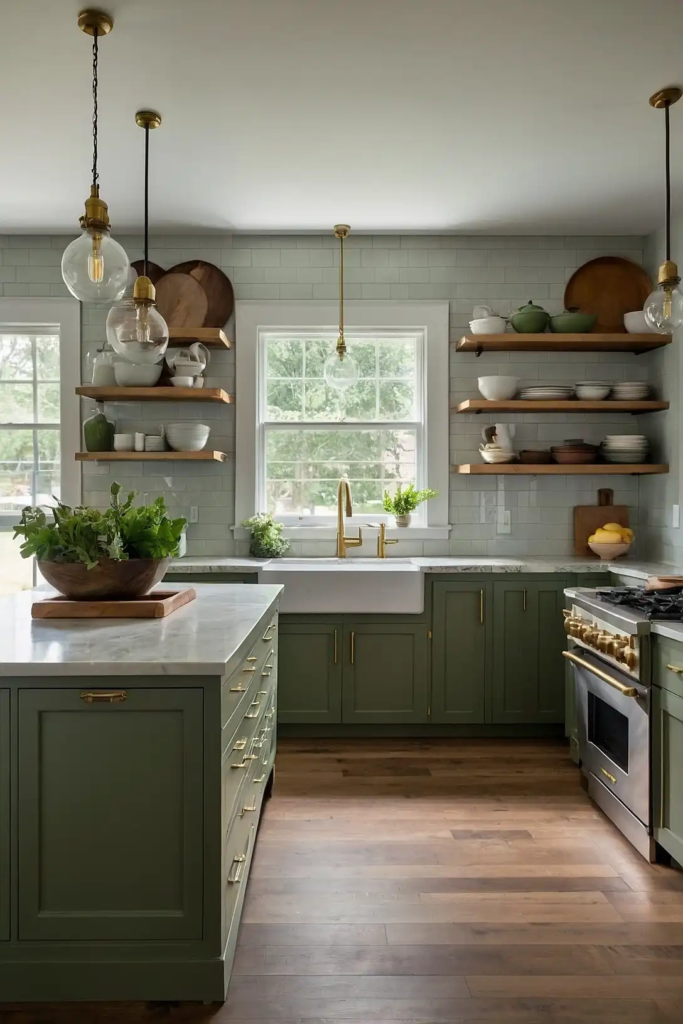
Pair sage green with natural wood elements for a nature-inspired palette that feels both contemporary and timeless. This combination balances cool and warm tones beautifully.
Incorporate wood through open shelving, countertops, or furniture pieces. The natural grain provides organic texture against more uniform sage painted surfaces.
Choose either light woods like oak and maple or rich walnut depending on your desired contrast level.
16: Sage Green Cabinet Interiors

Paint the inside of glass-front cabinets sage green while maintaining neutral exterior cabinet colors. This unexpected interior pop creates depth and interest.
The contained color application highlights displayed items without overwhelming your space. Use this technique to coordinate with small sage accents elsewhere in your kitchen.
This approach satisfies color cravings while maintaining a predominantly neutral kitchen.
17: Sage Green Pantry Door
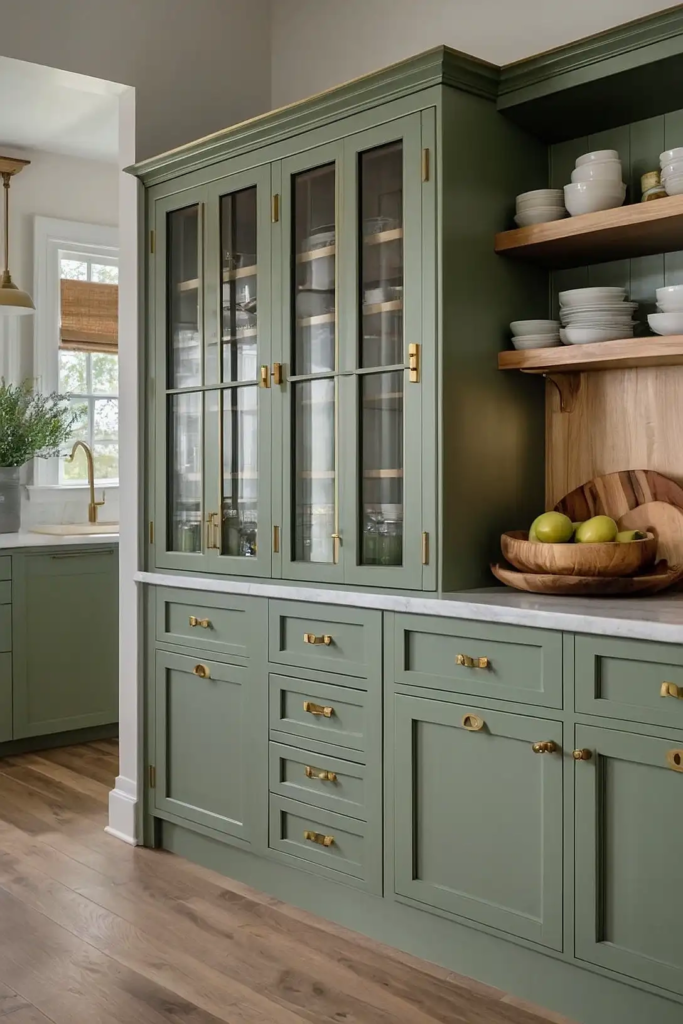
Transform your pantry door into a focal point with sage green paint that adds character to this functional element. This single door application creates significant color impact.
Consider adding vintage glass panels or modern geometric patterns for added interest. The vertical color plane draws the eye while defining the storage area.
This isolated color application works well in otherwise neutral kitchens needing a touch of personality.
18: Sage Green Banquette Seating
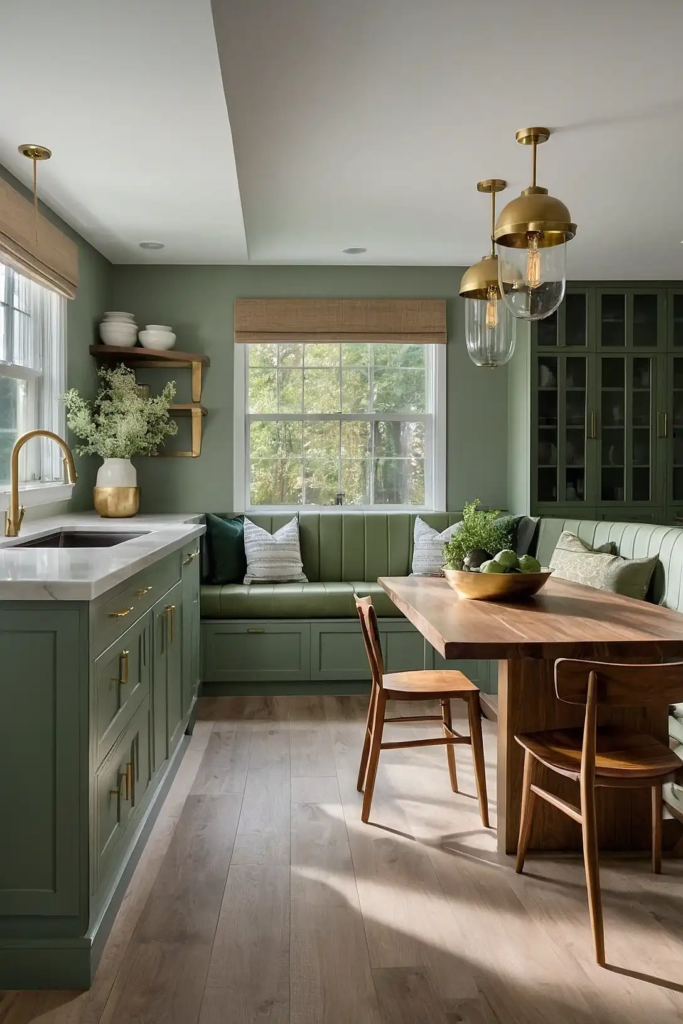
Install a built-in banquette upholstered in sage green fabric or vinyl that defines your eating area. This architectural seating creates both function and color impact.
Choose performance fabrics specifically designed for food-adjacent areas. The upholstered element softens kitchen hard surfaces while adding comfortable seating.
Incorporate storage drawers beneath for additional functionality within your color story.
19: Sage and Brass Hardware Combination
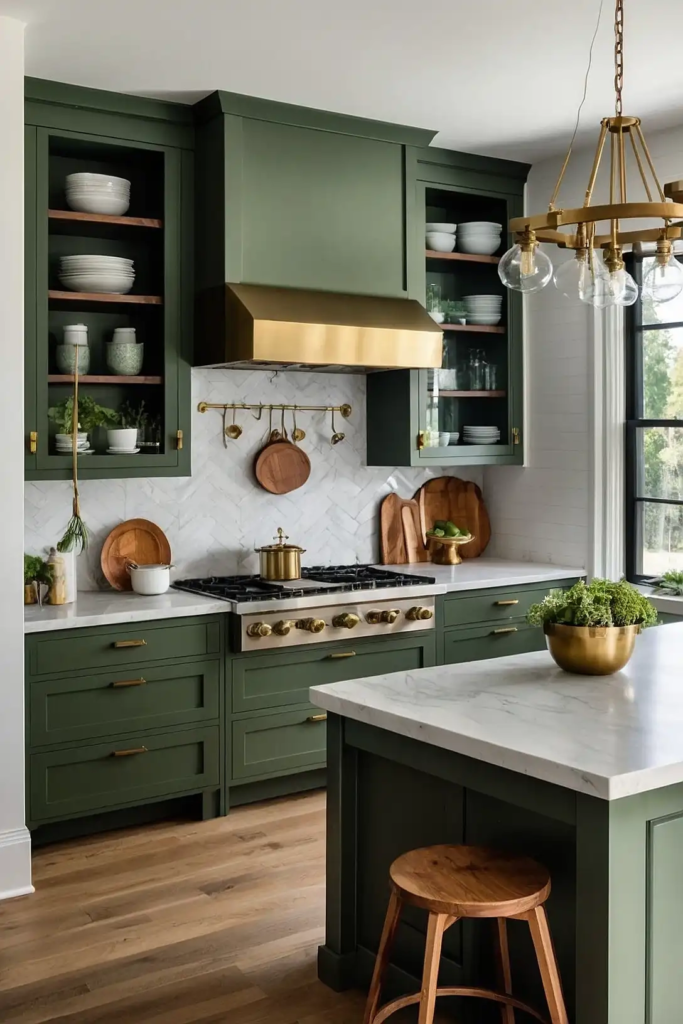
Update cabinet hardware with brass pulls and knobs against sage green cabinetry. This metallic contrast adds warmth and dimension to your color story.
Choose aged brass for vintage appeal or polished versions for more contemporary spaces. The small metallic elements catch light, creating sparkle against the matte sage background.
This simple hardware update transforms existing sage cabinets with minimal investment.
20: Sage Green Small Appliances
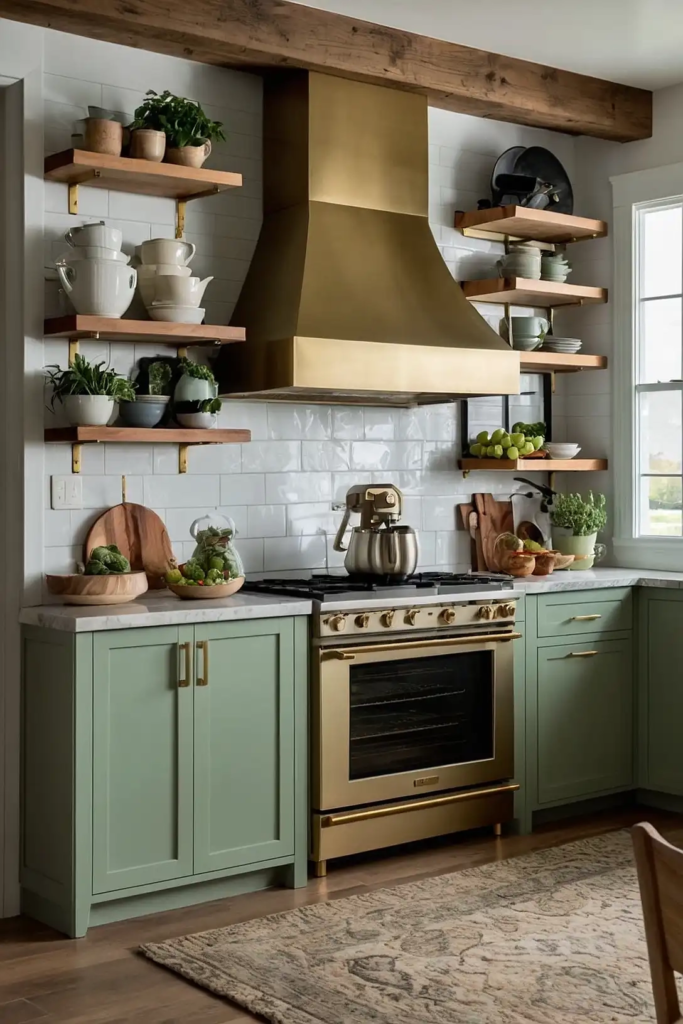
Display sage green stand mixers, coffee makers, or toasters that continue your color theme through functional objects. These everyday items become part of your design strategy.
Group complementary colored appliances together for maximum impact. The countertop color application creates consistency between work surfaces and vertical elements.
Major manufacturers now offer expanded color options, making coordinated appliances increasingly accessible.
21: Sage Green Cabinet Accents
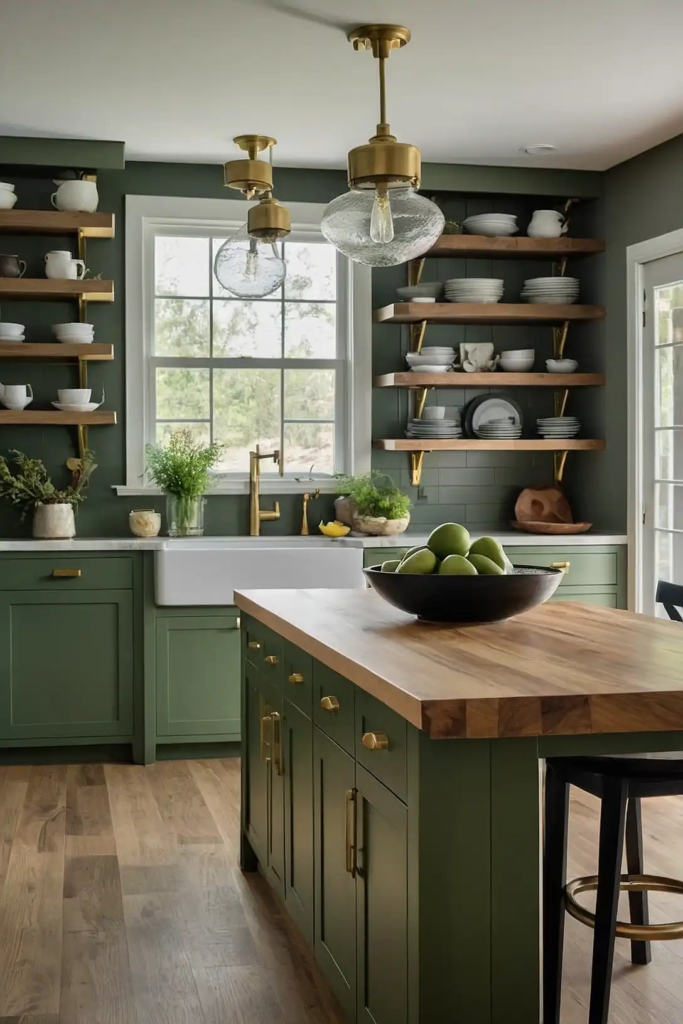
Add sage green bead-board panels, crown molding, or toe kicks to otherwise neutral cabinets.
These architectural details introduce color while maintaining a predominantly neutral kitchen.
Focus color application on elements that define cabinet structure for coherent design. The selective color creates dimension without the commitment of fully painted cabinetry.
This approach works particularly well when tying together varied cabinet styles in older homes.
22: Sage Green Kitchen Linens

Layer sage green dish towels, oven mitts, and chair cushions throughout your kitchen for low-commitment color. These textile accessories add softness to utilitarian spaces.
Choose various textures—waffle weaves, linen, and cotton—for dimensional interest. The distributed color points create rhythm throughout your kitchen.
This budget-friendly approach allows seasonal color adjustments without permanent changes.
23: Sage Green Pot Rail System
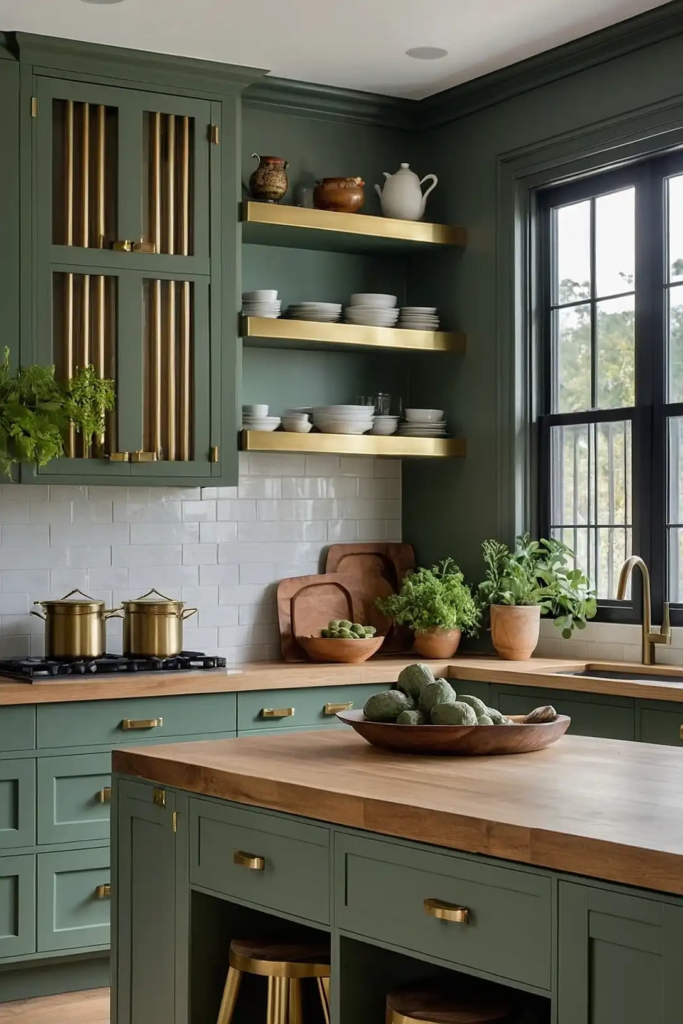
Install a sage green pot rail system that combines storage function with color. This wall-mounted element adds industrial character while organizing cooking essentials.
Choose copper or brass hooks for warm contrast against the cool sage. The linear element creates horizontal color that defines cooking zones.
Position at a practical height between backsplash and upper cabinets for maximum functionality.
24: Sage Green Window Trim

Paint window trim and mullions sage green while keeping walls neutral for architectural definition. This focused application highlights your kitchen’s natural light sources.
Choose slightly darker sage for trim than your wall color for subtle dimension. The framed views become more intentional with colored surrounds.
This application works particularly well in kitchens with multiple or uniquely shaped windows.
25: Sage Green Kitchen Art
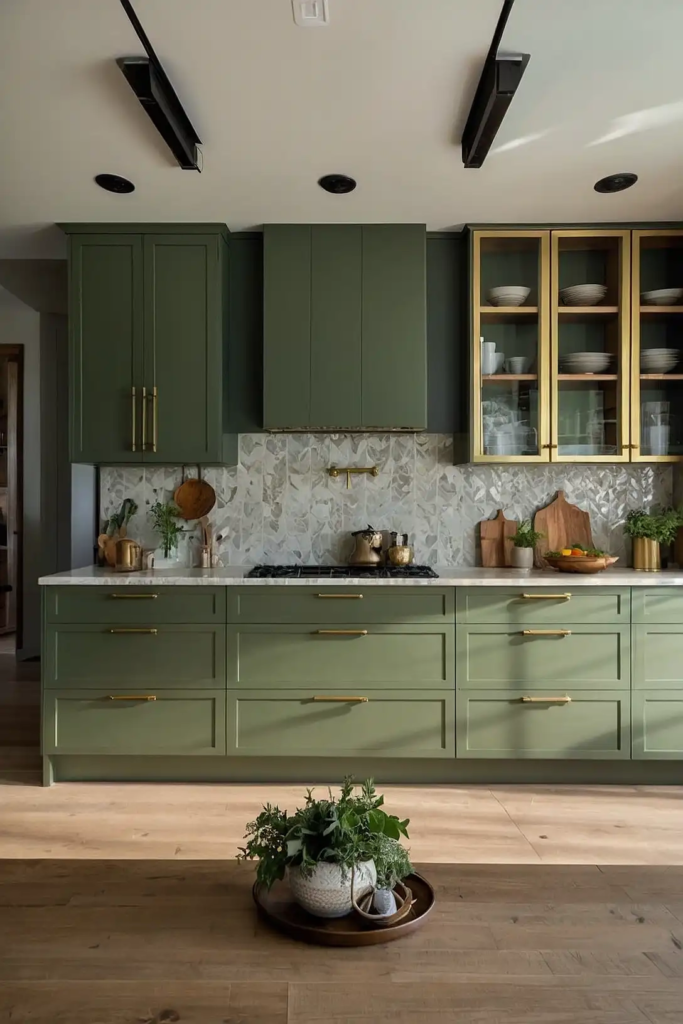
Hang artwork featuring sage green tones that reinforce your color story through decorative elements. These wall pieces add personality while maintaining color consistency.
Choose botanical prints, abstracts, or landscapes that incorporate your specific sage tone. The vertical elements add color at eye level in areas without cabinetry.
Frame in complementary materials like natural wood or brass for cohesive design.
26: Sage Green Refrigerator Panels
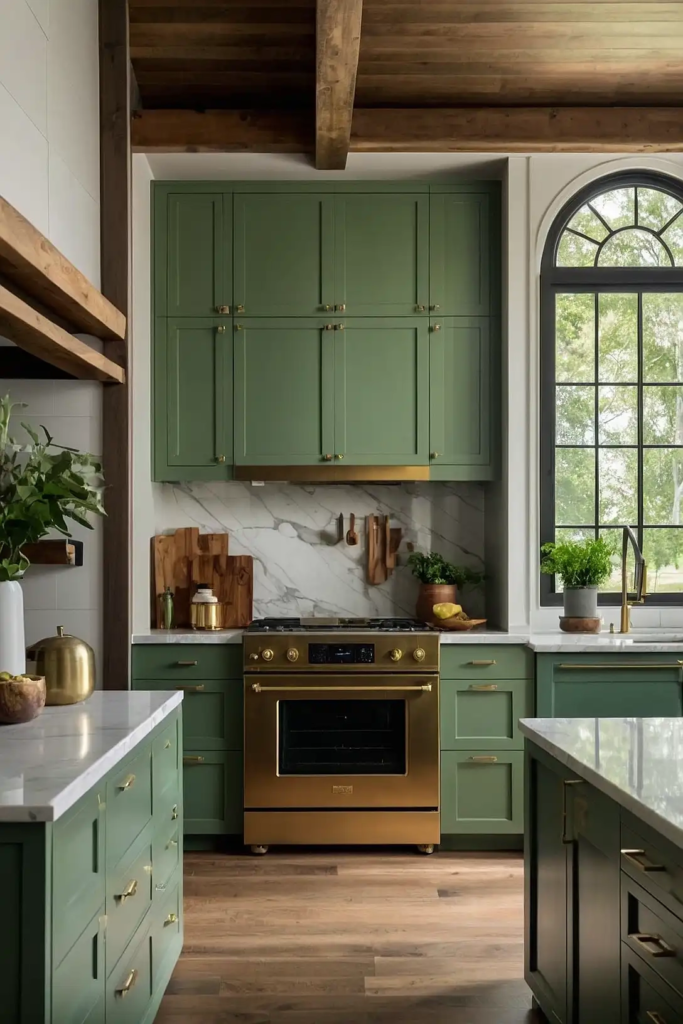
Replace standard refrigerator panels with sage green custom fronts that integrate this appliance into your color scheme. This significant vertical color plane creates substantial impact.
Choose panel materials that match your cabinet construction for seamless integration. The large color application transforms a utilitarian appliance into a design feature.
This approach works with many refrigerator models designed for custom panel application.
27: Sage Green Plant Display
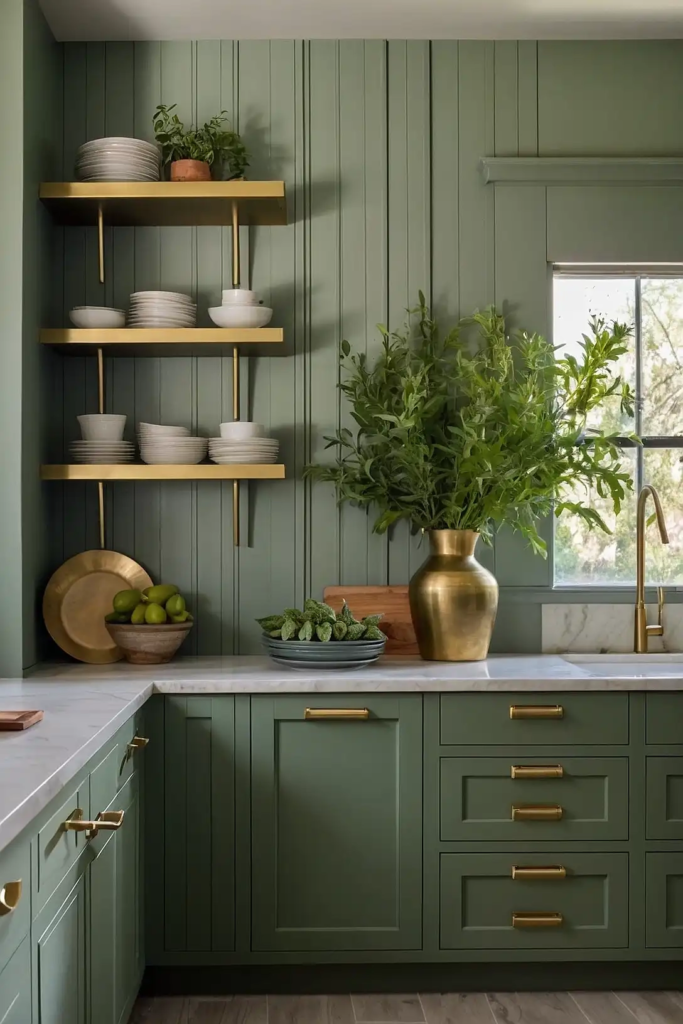
Group plants with silvery-sage foliage like eucalyptus, lamb’s ear, or sage herbs in coordinating containers. This living color application brings authentic nature into your palette.
Choose various plant sizes and growth habits for dimensional interest. The botanical elements reinforce your color story while improving air quality and cooking inspiration.
Position plant groupings on open shelving, windowsills, or as table centerpieces for distributed green accents.
Conclusion
Whether you embrace sage green through major elements like cabinetry or smaller accents like textiles, this versatile color creates kitchens that feel simultaneously on-trend and timeless.
Mix these ideas based on your commitment level and existing kitchen elements.






